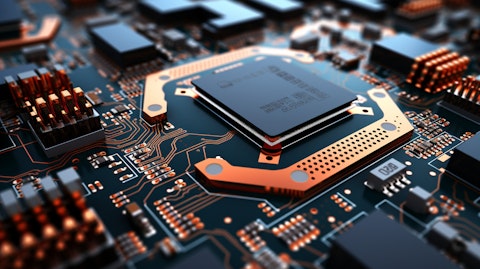We recently compiled a list of the BofA’s List Of AI & Semiconductor Stocks That Fund Managers Love & Hate: 16 Stocks On The Manager Radar. In this article, we are going to take a look at where Advanced Micro Devices, Inc. (NASDAQ:AMD) stands against the other AI and semiconductor stocks in BofA’s list that fund managers love and hate.
The initial wave of artificial intelligence investing has shaken up the stock market. Suddenly, technology stocks are divided between those that have exposure to AI and those that don’t. The former category has soared to set records while the latter has been lackluster because of the state of sluggishness in the non-AI business world.
Within AI stocks that have outdone themselves, semiconductor stocks are a standout. Additionally, just as is the case with broader technology stocks, semiconductor stocks are also divided between those with AI and non-AI exposure. The best example of the former category is Wall Street’s top AI stock pick. This stock is of a firm that designs and sells GPUs used to process AI workloads. Its shares are up 845% since the 2023 start and have set multiple records since OpenAI’s Chat GPT became publicly available.
On the flip side, another semiconductor stock has floundered during the same period even though it’s one of the oldest and largest semiconductor companies in the world. This stock belongs to a firm that is also one of the only three companies in the world that can manufacture high-end semiconductors and it is the only one which is headquartered in the US. While the GPU designer’s shares have gained 845%, over the same time, this semiconductor stock is down 13.9%, and year to date the shares have bled an unbelievable 53.14%.
Therein lies the bifurcation between semiconductor stocks that is fueled by the artificial intelligence wave. However, these returns might belong to the first stage of AI stocks only, implying that other semiconductor companies could also see gains provided robust AI software demand and the ability of firms to monetize their products. We covered a lot of such potential stocks as part of our coverage of Goldman Sachs’ Best Phase 2 AI Stocks: Top 24 High Conviction AI Stocks.
In this list, there were five semiconductor stocks. Four of these are semiconductor manufacturers while the remaining stock is the firm whose designs are the backbone of the modern-day smartphone industry. The stocks are ranked 19th, 16th, 14th, 8th, and 6th. Looking at their year-to-date performance, these stocks are up roughly 45%, 51.7%, 65.7%, 97.8%, and 122% year-to-date, respectively. Safe to say, the AI wave has been kind to these stocks. The next step in our brief analysis is to see what analysts believe the future holds for these firms. To do this, one particularly useful ratio is the forward price to earnings since it gauges the current price to analyst estimates of future earnings.
For these five phase two AI semiconductor stocks, the forward P/E ratios in respective orders are roughly 31.25, 50.51, 29.41, 25.19, and 99 times. The forward P/E ratio for global and US semiconductor stocks is 45.77 so most of these stocks are fairly valued. Consequently, this implies that in case of an AI correction that sees investor sentiment evaporate for any reason, these stocks might not be hit as hard as those speculating about an ‘AI bubble’ might worry, but if Wall Street finds more reasons to add to its AI euphoria, then their valuation might further bloom for more gains.
Shifting gears, the average forward P/E ratio for the semiconductor industry also leads us to wonder which stocks are driving this average value higher. After all, the six AI chip stocks we’ve covered above include some of the biggest companies in the world. However, high P/E ratios commonly belong to smaller companies that earn small profits but have a much higher share price. Two stocks that we’ve identified that have at least 2x the average forward P/E ratio are both unprofitable right now. The one with the higher forward P/E ratio of 196.08 ranks 20th on our list of Piper Sandler’s Top Technical Stock Picks: 20 Best Stocks while the second with a beefy ratio of 133.33 ranked 32nd on this list of AI stocks that were recently trending.
So, the next question to ask is, what makes these stocks so special that despite the fact that neither is currently profitable, investors have valued their shares more than 100 times over their projected earnings? Well, starting from the first stock with the higher P/E ratio, this firm is one of the few hardened integrated circuit manufacturers in the US. It makes radiation-resistant chips for the US military and its tools enable chip designs at various nodes. The second stock, which is up 49% year to date, is a specialty chip manufacturer that makes and sells silicon-based timing devices as an alternative to quartz-based products. These are used in applications such as edge computing and 5G networks – systems that are closer to end users and therefore must endure more strenuous working environments.
Our Methodology
To make our list of semiconductor stocks that fund managers love and hate according to BofA, we used its recent list of semiconductor stocks that were popular or losing popularity with fund managers. The list was divided into two sections based on expansion or decline in ownership. Stocks within each category were ranked by the number of hedge funds that had bought the shares during Q2 2024. For an interesting exercise, you can also compare these stocks with those on our lists of Goldman Sachs’ List Of Stocks That Hedge & Mutual Funds Love & Hate: 28 Stocks On The Mutual and Hedge Funds Radar.
For these stocks, we also mentioned the number of hedge fund investors. Why are we interested in the stocks that hedge funds pile into? The reason is simple: our research has shown that we can outperform the market by imitating the top stock picks of the best hedge funds. Our quarterly newsletter’s strategy selects 14 small-cap and large-cap stocks every quarter and has returned 275% since May 2014, beating its benchmark by 150 percentage points. (see more details here).

A close up of a complex looking PCB board with several intergrated semiconductor parts.
Advanced Micro Devices, Inc. (NASDAQ:AMD)
Number of Hedge Fund Holders In Q2 2024: 108
Section: Losing Popularity
Advanced Micro Devices, Inc. (NASDAQ:AMD) is the second biggest firm in the x86 CPU market which makes it quite important as this industry is effectively a duopoly. It competes with Intel in the CPU market and NVIDIA in the GPU market, making Advanced Micro Devices, Inc. (NASDAQ:AMD) the only firm capable of targeting both of the biggest chip companies in the industry. Additionally, acquisitions such as that of an FPGA company mean that Advanced Micro Devices, Inc. (NASDAQ:AMD) is a rare company capable of competing at all ends of the AI ecosystem, from CPUs to GPUs, and customizable chips. However, it is a distant second to NVIDIA in the GPU market and also depends on non-AI enterprise data center spending for a large portion of its revenue. Yet, Advanced Micro Devices, Inc. (NASDAQ:AMD) could see tailwinds as AI use accelerates in the business world and firms seek low-cost accelerators amidst supply constraints for NVIDIA products.
Advanced Micro Devices, Inc. (NASDAQ:AMD)’s management commented on its data center business during the Q2 2024 earnings call. Here is what they shared:
“Turning to the segments, data center segment revenue increased 115% year-over-year to a record $2.8 billion, driven by the steep ramp of Instinct MI300 GPU shipments and a strong double-digit percentage increase in EPYC CPU sales. Cloud adoption remains strong as hyperscalers deploy fourth-gen EPYC CPUs to power more of their internal workloads and public instances. We are seeing hyperscalers select EPYC processors to power a larger portion of their applications and workloads, displacing incumbent offerings across their infrastructure with AMD solutions that offer clear performance and efficiency advantages.
The number of AMD-powered cloud instances available from the largest providers has increased 34% from a year ago to more than 900. We are seeing strong pull for these instances with both enterprise and cloud-first businesses. As an example, Netflix and Uber both recently selected fourth-gen EPYC Public Cloud instances as one of the key solutions to power their mission critical customer facing workloads. In the enterprise, sales were increased by a strong double-digit percentage sequentially. We closed multiple large wins in the quarter with financial services, technology, health care, retail, manufacturing, and transportation customers, including Adobe, Boeing, Industrial Light & Magic, Optiver, and Siemens. Importantly, more than one-third of our enterprise server wins in the first half of the year were with businesses deploying EPYC in their data centers for the first time, highlighting our success attracting new customers, while also continuing to expand our footprint with existing customers.”
Overall AMD ranks 11th on our list of the AI and semiconductor stocks in BofA’s list that fund managers love and hate. While we acknowledge the potential of AMD as an investment, our conviction lies in the belief that some AI stocks hold greater promise for delivering higher returns and doing so within a shorter timeframe. If you are looking for an AI stock that is more promising than AMD but that trades at less than 5 times its earnings, check out our report about the cheapest AI stock.
READ NEXT: $30 Trillion Opportunity: 15 Best Humanoid Robot Stocks to Buy According to Morgan Stanley and Jim Cramer Says NVIDIA ‘Has Become A Wasteland’.
Disclosure: None. This article is originally published at Insider Monkey.





